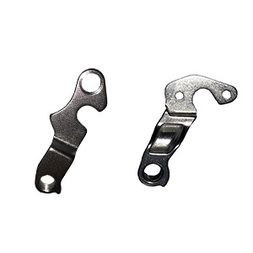Cycling Tips Review MicroShift Advent X
.jpg)
MICROSHIFT ADVENT X GRAVEL BIKE GROUPSET REVIEW: BIG RANGE, SMALL PRICE
With a rear derailleur, a wide-range cassette, and a pair of dropbar shifters all for US$287, you’d be easily excused for assuming that MicroShift’s Advent X drivetrain components are kinda crummy. Instead, they’re solid proof that bike parts don’t need to be expensive to function reliably.
In a market almost devoid of low cost 1x drivetrain options suitable for gravel riding, this single-ring mini-groupset is a glimmer of hope. However, some aspects of it shine brighter than others.
It’s been a year since I first installed these single-ring 10-speed components on a well-loved cyclocross bike and it’s well past time I shared my findings.
The current state of play for 1x groupsets
Story Highlights
-
What:
A rear derailleur, cassette, and shifter set that creates a single-ring drivetrain at a relatively low price.
-
Key Features:
11-48T cassette, 10-speed shifting, mountain bike or dropbar shifter available, clutch-equipped rear derailleur. BYO chain, crank, brakes, and chainring.
-
Weight:
Rear derailleur (316 g), G-Series cassette (416 g), pair of dropbar shift/brake levers (384 g)
-
Price:
Rear derailleur (US$72 / AU$120), G-Series cassette (US$65 / AU$110), Dropbar shifter set (US$149.99 / AU$240)
-
Highs:
Price, generous gear range, simple setup, easy fit to many existing and older bikes, did I mention price?
-
Lows:
Shifter ergonomics, no hydraulic brake option for dropbar bikes, shifting a little clunky, sizeable jumps between gears.
There’s little denying that single-ring drivetrains are here to stay. The front derailleur is well and truly dead in the mountain bike world. Meanwhile, the gravel market remains divided on the topic with the front derailleur still having a place for bikes that toe the line between road and off-road.
Mountain bikers on a tight budget have a healthy pool of single-ring drivetrain options. As the first movers, SRAM has its 12-speed Eagle down at the super cheap SX level. Meanwhile, Shimano has its 12-speed technology starting at a slightly higher Deore level. SRAM offers an 11-50T (or a more premium 10-52T) cassette range, while Shimano sits at 11-51T (or 10-51T). And while SRAM is all-in on 12-speed, Shimano also offers wide-range 11- and 10-speed options which are even cheaper than the 12-speed Deore counterparts.
However, it’s slim pickings when it comes to comparably affordable single-ring drivetrain options for a bike with drop handlebars (like a gravel bike). SRAM still offers its 1×11 groups with a limited 10/11-42T cassette range, while Shimano’s 11-speed GRX can handle an 11-46T range (even if it’s not officially recommended). And neither of these options are at a truly low price point.
Shimano and SRAM’s dominance in the higher end space has forced the hand of a few smaller brands to really play the value card, and there are some truly intriguing options here – Microshift being a prime example.
Priced low and yet the most premium option from the company, MicroShift’s Advent X is a high-value 10-speed single-ring groupset with a gearing range that almost rivals those with 12-cogs in the back. Perhaps most unique is the fact Avent X can be run with either a mountain bike or dropbar shifter.
.jpg)
The group you’re here for, Microshift’s Advent X (consisting of just a rear derailleur, cassette and shifters) is one of the few low-cost and wide-range drivetrain options available in the gravel world.
Even cheaper and with 11 cogs in the back is Sensah’s SRX gravel group which can be bought directly out of China via e-commerce platforms such as Aliexpress. My colleague Iain Treloar is currently testing this group and he’ll have a review in the future. On paper, it seems like Sensah’s SRX is well worth a look, but inherently there’s an element of risk in buying such a consumer-direct brand with no local support. By contrast, MicroShift has obvious product support, an established global distributor network, and designs that are arguably more their own (and therefore can seemingly be sold in a global market without the risk of infringing patents).
Yet another option low-cost option is MicroShift’s XLE shifters which are available in 10- and 11-speed versions to respectively work with 10- and 11-speed Shimano MTB rear derailleurs. These share a closely comparable shape and function to the MicroShift Advent X shifters reviewed here and so elements of this review may be applicable to such a setup.
As for a quick explainer on the gearing range offered by Advent X, you may have read somewhere that the fresh gravel-specific SRAM XPLR cassette offers a 440% range versus the 520% of SRAM’s latest Eagle cassettes. Or that older 1×11 SRAM cassettes offered a 420% range. By comparison, Advent X offers a 436% range, and while that sounds far less impressive, it’s worth noting that a large part of this difference is because Advent X offers an 11T smallest cog versus the 10T of the premium-priced offerings.
How do 2x drivetrains compare? Well, a 2x drivetrain running a compact crank (50/34T) and a 11-34T cassette offer a 454% range. Swap out to a 11-32T cassette and it’s a 427% range. As another example, a 2x Shimano GRX drivetrain running a sub-compact crank (48/31) and an 11-34T cassette offers a 479% range.
As you can see, when it comes to the total gear range from the highest to the lowest, Advent X is in the same race. However, with fewer cogs in the back, there is of course a steeper progression with each gear shift – something we’ll get to in a moment.
.jpg)
Designed as a single ring-only drivetrain, Advent X’s gear span is roughly equivalent to a 2x compact crank with an 11-32T cassette. Of course, a smaller chainring will make for an easier low gear.
Advent X explained
MicroShift has been on a steady rebranding path in recent years. Its original nine-speed Advent components broke new ground for the company by hitting a staggeringly low price while offering a choice of 11-42 or 11-46T wide-range cassettes.
Now in its second year, Advent X remains MicroShift’s top-tier offering. The group consists of a 10-speed shifter (in either mountain bike or dropbar form), a rear derailleur, and an 11-48T cassette combo. MicroShift then leaves the selection of a suitable 10-speed chain, crankset, and single-ring chainring up to you. While some brands do equip these parts on whole bikes, it’s arguably more intriguing as a low-cost aftermarket 1x shifting conversion for existing bikes.
.jpg)
This is what the dropbar version of Advent X consists of. Change out the shifters for the MTB version.
While the vast majority of Advent X customers are using the mountain bike paddle shifter, I specifically wanted to test MicroShift’s compatible drop bar brake lever/shifters. Most notably, these Advent X shift/brake levers (aka “brifters”, but I despise that word) are only available to drive mechanical brakes with a road-type cable pull – whether they be road rim callipers, cantilevers, mini Vs, mechanical disc brakes, or Hybrid Hydro disc brakes (such as TRP’s Hy/Rds).
The dropbar shift levers feature a shape closely comparable to Shimano Sora or, if you go back further, to the golden age of Shimano 10-speed mechanical parts where the shifter cables were still external of the shifter. That external gear shift cable applies here, while the brake cables are run against the bar and below the bar tape. There is no shift mechanism on the left shifter, but the right stacks the up and downshift levers one above the other. The pair weighs 384 g (not including the cables). Inner cables and outer housing are provided, too.
.jpg)
I fitted the Advent X group to a well-loved and gently weathered canti-equipped Salsa cyclocross bike.
Weighing in at 312 g, the rear derailleur is predominately made with a sturdy alloy construction and impressively features a chain retaining clutch mechanism that offers an on-off switch that’s arguably easier to use than Shimano’s lever. Meanwhile, the pulley wheels are large 13T items – it’s almost like an OSPW (except it’s not hundreds of dollars)!
MicroShift’s 11-48T cassettes fit any regular eight-, nine-, 10-, or 11-speed Shimano-style HG freehub. And unless you’re running Campagnolo, there’s a good chance your old rear wheel is ready for it. Microshift offers two price point versions of the cassette, both of which are given a black anti-corrosion treatment.
As tested, the more-expensive-but-not-that-expensive ‘G-version’ tips the scales at 416 g (actual) and uses a few aluminium elements to hit that weight. All but the smallest cogs are pinned to an aluminium spider, while the two biggest cogs are also aluminium. The eight remaining smaller cogs are made of steel.
.jpg)
Just look at the size of those cogs! This cassette is designed as a direct-fit for eight/nine/10-speed HG freehub bodies, but you’ll need to add a 1.85 mm spacer if fitting to a newer 11-speed road freehub body.
Spending US$20 less gets you the “H-Version” at 575 g (claimed) which does away with the weight-relieving spider or alloy big cogs. It’s an all-steel affair. Both cassette options feature a relatively big jump between the easiest (48T) gear and the next one down. The ratio spread is 11-13-15-18-21-24-28-34-40-48.
The component weights may not sound like anything special, but they’ve got comparable parts from Shimano and SRAM against the ropes. Notably, the 416 g figure for the US$65 11-48T cassette is impressive when you consider a US$105 Shimano XT 11-46T 11-speed cassette is 437 g. What about a more price comparable cassette? Well, SRAM’s PG-1130 11-42T 11-speed cassette retails at US$99 and weighs 529 g, and that’s despite the noticeably smaller total gear range.
As mentioned, the chain, crank, and chainring are left up to you. For my testing, I ran a low-cost YBN e-bike 10-speed chain which offered 126 versus the regular 116 links (likely needed when combining a 40T+ chainring with a 48T cassette). Up front I used the old RaceFace crank and matching 1x chainring that I already had on the bike. You shouldn’t have any trouble finding an aftermarket 1x chainring to match your existing crankset but I strongly recommend one with a narrow-wide profile (WolfTooth being just one proven option).
Riding Advent X
Advent X is effectively three drivetrain components, but when we’re talking about it from a gravel or drop bar perspective then it’s worth talking about what it's not and what it stops you from doing.
Notably, the drop bar shifters lock you out of full hydraulic disc brakes. That’s likely of zero concern if you’re using an older rim brake bike (like I did), but it is certainly a key decision if you’re rocking discs.
I won’t make this group review a debate about hydraulic vs mechanical disc brakes, but I will say that if I were building a new gravel bike from scratch I’d personally want it to have full hydraulic brakes. I’ve used just about every mechanical disc brake and hybrid hydraulic setup (many of them with the best compressionless cables), and in my opinion all sit a step or two behind a good full hydraulic setup in terms of absolute braking performance. Now that sacrifice in absolute performance may not bother some people or even be detectable by others, but fundamentally there is a trade-off.
All of this is to say that on a modern bike your braking decision is going to be closely related to your drivetrain decision, and a group like Advent X may be ruled out before you even start to think about gearing ratios and shift quality. Then again, if your budget only stretches as far as something like Advent X, then you’re likely only looking at mechanical brakes anyway.
.jpg)
The shifter shape is quite close to that offered by older-generation Shimano shifters.
Of course, all the woes with the hood shape don’t matter a whole lot once you’re in the drops, and here the shape of the brake lever offers a comfortable hold.
Notably, there is no lever reach adjustment to assist those with smaller hands. However, much like with lower-end Shimano offerings, the reach can be customised by wedging something (like a piece of adhesive foam) inside the top of the hood where the brake lever bottoms out.
There are only so many ways a dropbar shifter can work without infringing on a fiercely protected patent. MicroShift’s answer is to stack the higher and low shift one above the other. The button up top releases the derailleur to a harder gear, while the lever beneath it is pressed inward to pull the derailleur up to an easier gear.
.jpg)
The two shift buttons are stacked.
The shifter mechanism is notably simple. With an almost one-to-one cable pull ratio, initiating a shift requires the respective shift lever to be moved by a decent amount. And while there’s a multi-shift feature for the lower lever, this long swing angle meant I only ever shifted one gear at a time. The shift button positions work, and with a little practice, I found myself tapping the top button with my index finger and then swinging the lower button with my middle finger.
There’s a real positive feel with an unmistakable “click-clack” at the shifter with each change. In this sense, the shifting action is more akin to SRAM’s ‘get into that gear damnit’ feeling versus Shimano’s more polite ‘please get into that gear but don’t make a scene’ feeling. Additionally, the feel at the shifter is a little mushier compared to the two Big S’s, but each shift always goes to the cog you desire.
Squeeze the brake lever and you’ll see the gear shift cable spool exposed within. I actually quite like this open design as checking for cable condition (e.g. not frayed) is really as simple as pulling on the brake lever. And while this open design means it may be more susceptible to collecting dirt, it’s also all the easier to clean out and re-lube. MicroShift has indeed made it easy to do routine maintenance.
My final note on the shifters relates to the external gear cable housing. This is a blessing for easy setup and maintenance but it does leave the housing and plastic shifter body more susceptible to damage. A direct impact to the housing or cable barrel adjuster can take a part of the shifter with it so there are some benefits to concealed housings beyond aesthetics alone. Of course, you’ll only ever find out if this is an issue after an unfortunate event.
.jpg)
The exposed shift housing is something to be careful of if you have a habit of running into trees and poles. My sample is still perfect, for the record.
I have far fewer complaints about the rear derailleur and cassette. Frankly, the shift quality, consistency, and chain retention all blew me away for what these parts cost, and it’s this solid performance that only furthered my frustrations with the drop bar shifters – this setup is so close to being great!
The rear derailleur moves the chain as required and offers a surprising amount of positivity in the process. The construction is solid, with no noticeable play in the pivots or flex in the cage. Chain retention is also great thanks to the rather unique ratchet-and-pawl-based mechanism that stops the derailleur cage from bouncing around under the weight of the chain. The clutch tension is adjustable with basic tools and there is a clever off-on switch to make wheel removal and installation simple.

An exploded diagram showing the clutch mechanism of the Advent X rear derailleur. There sure are a lot of small pieces, but it’s not all that different to what’s likely inside your rear hub.
Shifting under load is a little clunky, but that’s also to be expected of a 10-speed group with big jumps between each cog. Going to smaller cogs is clunkier than going up the cassette. But while it may be slightly clunky, the derailleur does always, albeit sometimes slowly, hit the intended gear.
The cassette runs smoothly enough and I haven’t experienced any worrying concerns in relation to durability or weaknesses in the alloy spider-based construction. That said, the comparatively low weight means the larger cogs aren’t quite as rigid as heavier cassettes from Shimano and SRAM. This doesn’t seem to affect performance but it may be a small part of why the shifts aren’t quite as crisp as from the big players.
Speaking of durability, the cheaper version of the cassette which features all-steel cogs will likely outlast the lighter cassette tested that uses a softer material for the two biggest cogs. Whether this wear is at all a problem will greatly depend on what gears you ride most.

Advent X can feel quite rough if shifting under full load. And that makes sense given the big steps for the chain. Back off the power and you’ll be met with surprisingly smooth shifts.
My big qualm with the cassette is the spacing. With an enormous 11-48T spread across just 10 gears, compromises are unavoidable. There are noticeable steps between each shift, but those steps become quite apparent as you get into the easier gears. While noticeable, the jumps are quite manageable and often even welcomed in off-road terrain, but such jumps will reveal the limitations of such a setup if trying to match pace with others on the road.
Impressive for the price but best served on a MTB
By now it should be rather obvious that MicroShift’s Advent X is really at its best with the mountain bike shifter and in such a configuration it truly is an impressive low-cost upgrade option for bikes of old and new. The gearing range, ease of setup, chain retention, and shift action almost embarrass the two big companies that start with S, given the asking price.
Sadly it’s a slightly different and less glowing story in the drop bar configuration. Here, it still ticks a heap of boxes at a price point that neither Shimano or SRAM truly play in, but the somewhat aged approach to hood ergonomics is the weak link in the otherwise impressive package. Still, I suspect many who don’t have much of a comparative library will make do just fine and be more than happy, but that doesn’t change the fact that it could be better.
There’s no denying that MicroShift planned it would sell far more of its Advent X groupset to mountain bikers than those running drop bars. And I think that’s rather evident. In the gravel configuration, it’s almost like a delicious bowl of ice cream served with a fork. It’s so damn good, but you don’t quite have the right utensil to enjoy it all.
You can also read the full article here.
 AUS
AUS USA
USA




.jpg)



























